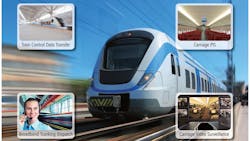Metro systems continually face a variety of communications problems including disconnected networks between train and ground systems, interference, and intermittent service. A new solution based on enterprise Long Term Evolution (eLTE) aims to provide more reliable, bilateral radio-transmission channels for train-to-ground voice, data, and video transmissions. In doing so, it should boost overall communication and operational efficiency for rail transportation.
Developed by Huawei and currently deployed in China for Zhengzhou Metro, the eLTE urban rail-transportation solution features a variety of anti-interference technologies. Offering throughput to 100 Mb/s with low-latency transmission, it can be customized to the operator’s frequency resources from 400 MHz to 5.8 GHz. In difficult coverage environments, such as deserts, tunnels, and bridges, both traditional macro and advance distributed base transceiver stations (BTSs) can be employed for continuous coverage. The professional broadband trunking system supports simultaneous voice and video dispatching for greater efficiency. Passengers also will benefit from travel and entertainment information, such as route guidance, weather forecasts, and WiFi.
In August 2013, Huawei deployed the first commercial application of a 3.6 ~ 3.8-GHz eLTE system in Poland to provide more efficient government communications. Reportedly, the fourth-generation (4G) wireless system provides carrier-grade resilience with features that can be set up and maintained more easily than traditional solutions. Providing coverage over a range of 100 km even in demanding areas, the network uses 20 MHz of bandwidth and 2x2 multiple input multiple output (MIMO) technology to support downlink data rates to 100 Mb/s and uplink data rates to 50 Mb/s.
For the eLTE-based rail solution, applications targeting metro operators include closed-circuit television, passenger information systems (PISs), communication-based control (CBTC), vehicle-mounted video surveillance, and broadband trunking. Techniques like automatic frequency control (AFC) are employed to deal with the Doppler effect and increase successful handover rates. In 2010, the solution was demonstrated on the Shanghai Maglev Train. At that time, it provided 50-Mb/s broadband services on trains traveling 430 km/h.
About the Author
Iliza Sokol
Associate Digital Editor
Iliza joined the Penton Media group in 2013 after graduating from the Fashion Institute of Technology with a BS in Advertising and Marketing Communications. Prior to joining the staff, she worked at NYLON Magazine and a ghostwriting firm based in New York.
